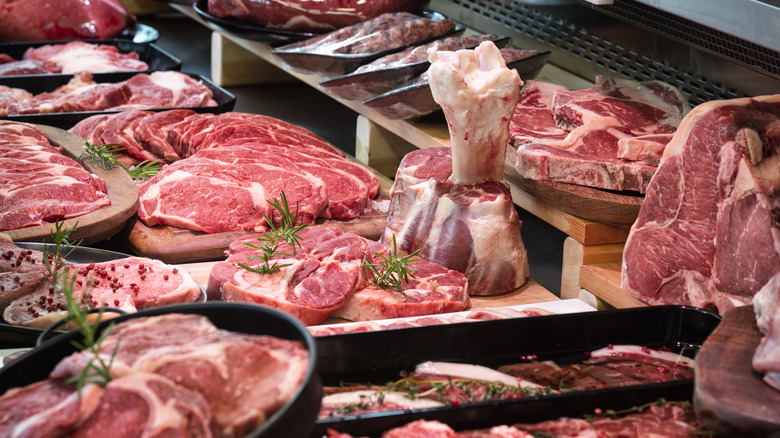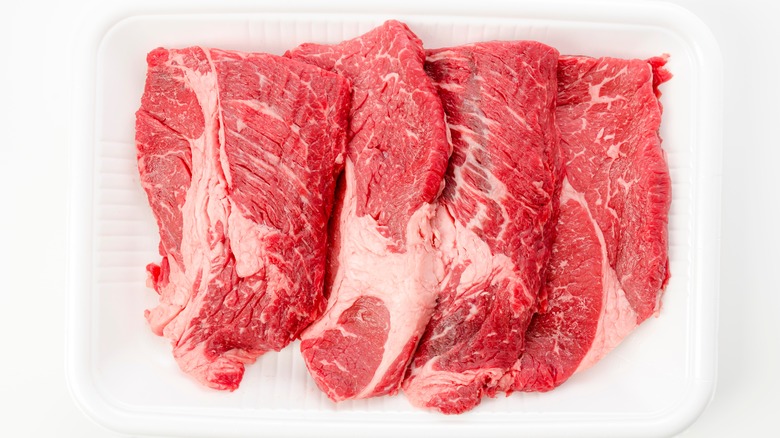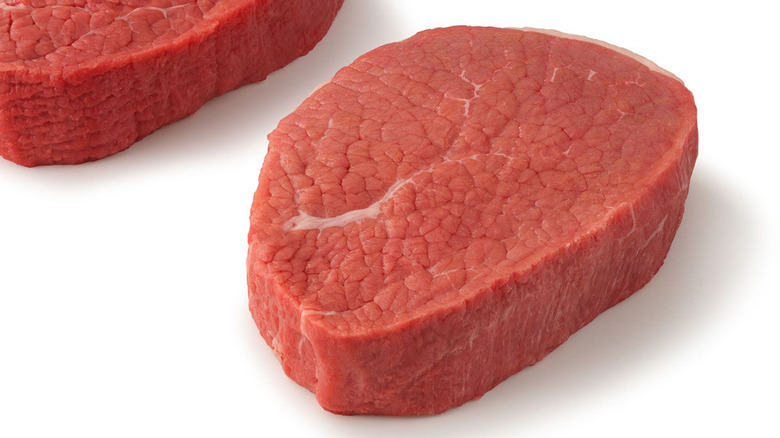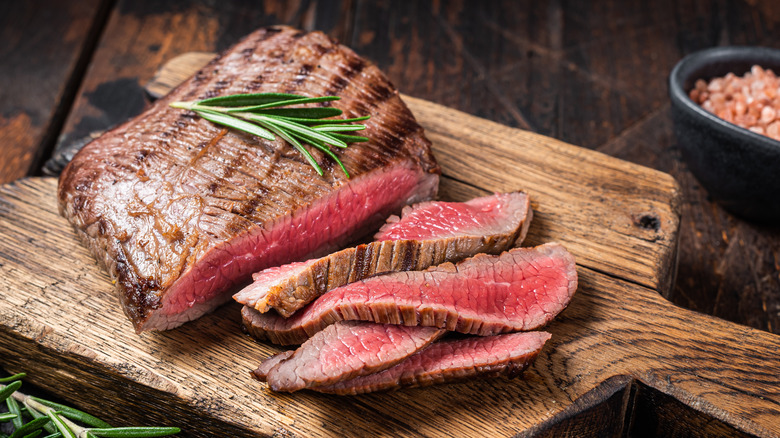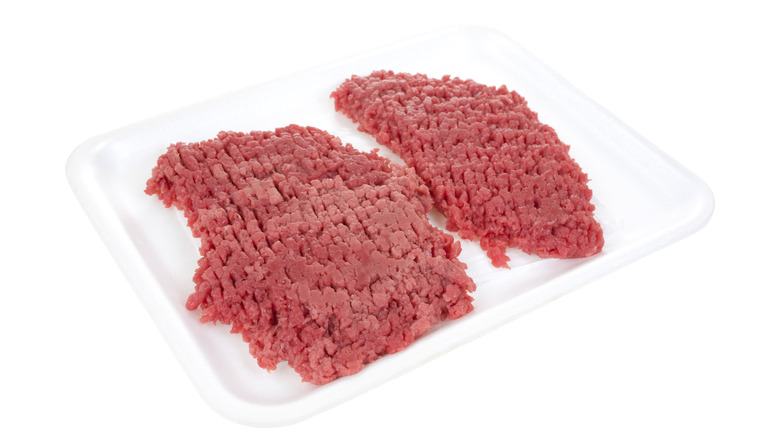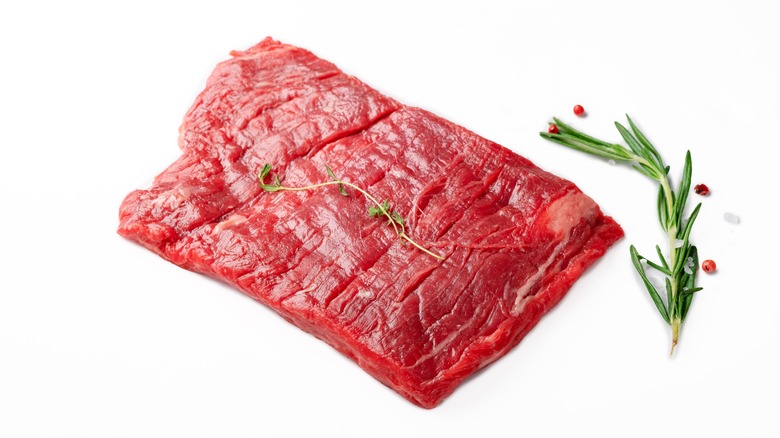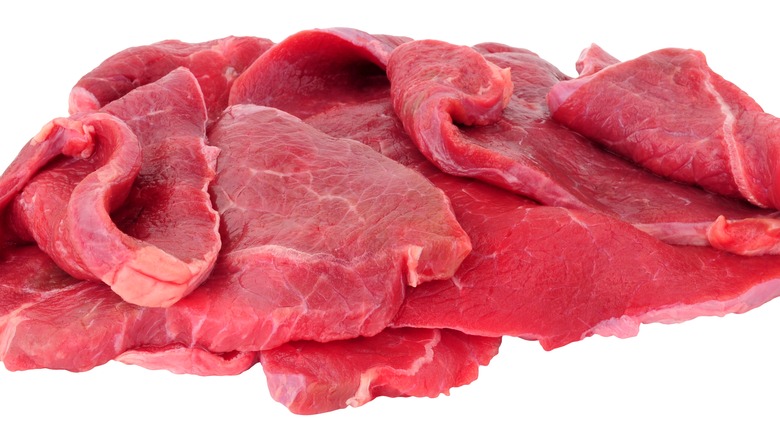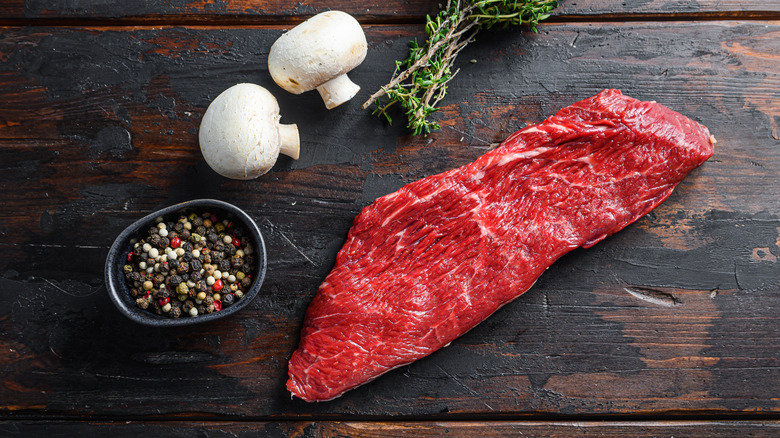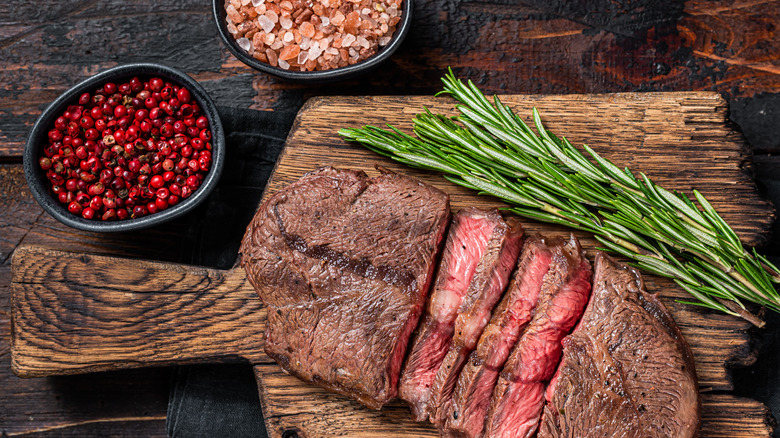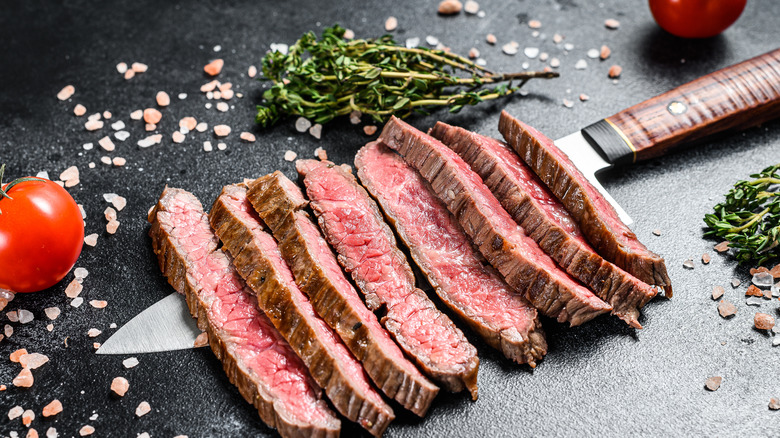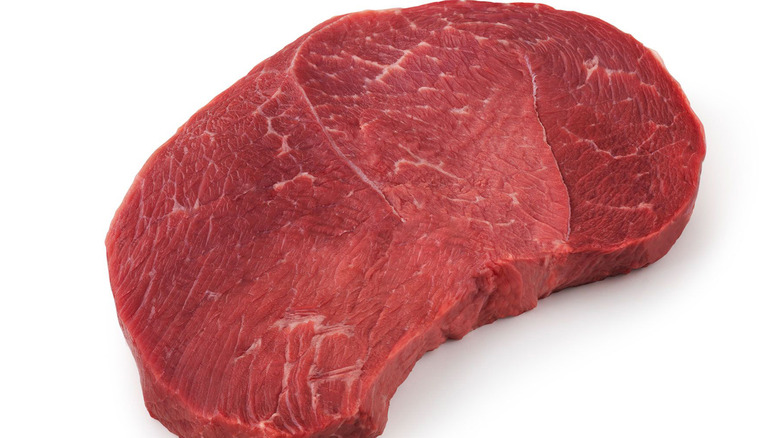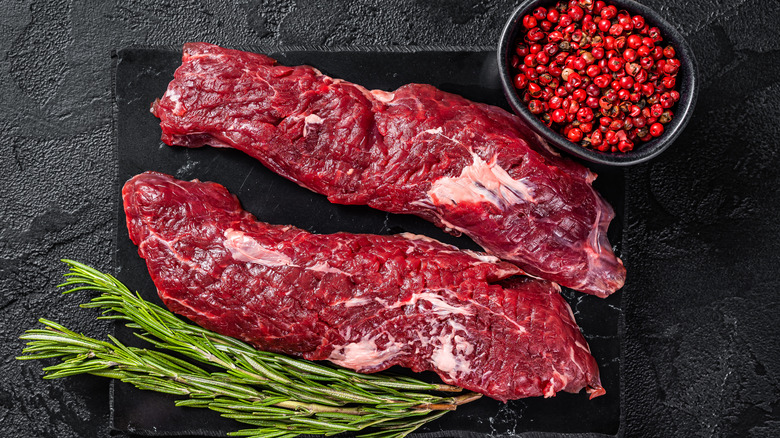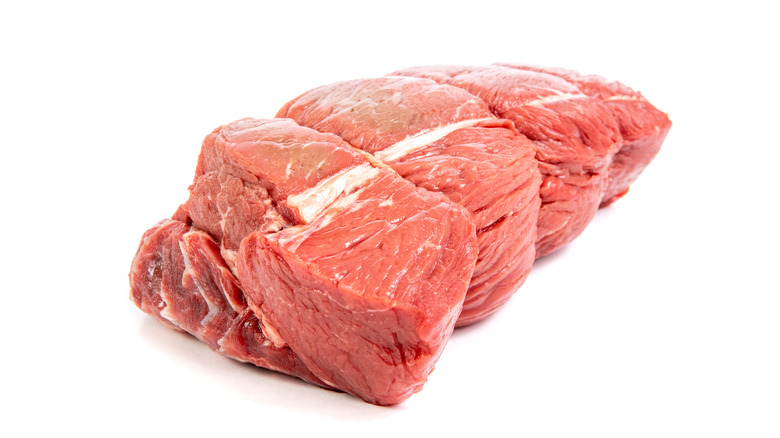6 Budget-Friendly Cuts Of Steak To Buy And 6 To Avoid
When you think of steak, you probably think of it as a premium meal, one that commands a higher cost, whether you're eating out or preparing it at home. This is likely due to the popularity of expensive cuts that have garnered a well-deserved reputation for their juiciness and superior flavor — a reputation that comes with a hefty price tag.
Fortunately, consumers have wised up to lesser-known cuts of steak that are far more affordable, and suppliers have been more than happy to offer more options to meet demand. Having said that, not every cut in this wider selection is up to par if you're after an excellent steak, and the variety can be both confusing and inconsistent.
A good butcher is preferable to a grocery store, as they can advise you on which cuts are best suited to what you're trying to do with them. They'll also likely have a better selection and can slice off fresh steaks from larger cuts — and they're not necessarily more expensive than the grocery store. If you do buy your steak from the store, pay close attention to the labels, as many cuts have similar names but are by no means similar. By following this guide, you'll get a better idea of budget cuts that are available, as well as which ones to buy and which to avoid if you're after a delicious, perfectly cooked steak.
Buy: Chuck eye steak
Often referred to as the "poor man's ribeye," chuck eye is an excellent budget steak cut, if you can get hold of it. Like the ribeye, chuck eye steak also comes from the shoulder of the cow, from a section known as the chuck primal, and is cut from the fifth rib.
What makes the chuck eye special is that it's taken from the same area of muscle as the ribeye, where it extends to the upper shoulder. The result is a cut that's admittedly not quite as tender but packs a ton of rich, beef flavor. It's worth mentioning that despite being a great budget cut, it's not too often you'll find it at a regular grocery store — you'll probably have more luck at a butcher shop.
Because the chuck eye is taken from a larger cut, called the chuck roast, it's often sold as a bigger cut of meat for slow cooking or roasting, but a butcher should be able to divide up the larger portion for you. To make the most of chuck eye, it's best to cook on high heat while being careful not to overdo it at the risk of making it too tough and chewy — you'll also want to keep the doneness to medium-rare at the highest.
Avoid: Round steak
Taken from the hindquarters of the cow, round steak is a budget-friendly cut that should be readily available in most supermarkets and butchers, but it's not well-suited for pan frying or grilling. Like most cuts taken from muscles that see a lot of movement, the round steak is much leaner and tougher than other cuts.
Cuts from the round can be somewhat deceptive at first glance. When raw, they can appear just as thick and juicy as prime cuts to the untrained eye. However, their shortcomings become far more noticeable if you cook them the same way as higher-quality cuts from the sirloin.
That's not to say round steak can't taste great when prepared in the right way, just that if you try cooking it quickly over high heat, you're likely going to end up with an extremely chewy piece of meat. Thanks to a lack of fat and marbling, the round steak dries out quickly with dry heat, so the key is low and slow.
You can use a meat tenderizer to soften the meat and boost its tenderness, but slow cooking or braising is the way to go, as these will help the beef retain moisture. Using a crock pot, it's possible to cook round steaks to melt-in-your-mouth perfection in four to eight hours depending on the thickness of the cut, but you'll struggle to achieve this result in a pan.
Buy: Flank steak
While flank steak isn't as tender as other cuts of beef, being taken from the abdominal muscles of the cow running from the rib end to the rump, it doesn't take much work to turn it into a beautifully soft and tasty piece of meat. Flank steaks pack in a lot of flavor already, but you'll want to marinate it for at least 30 minutes before cooking to tenderize it.
Cutting it thinly enough and grilling or broiling it to medium-rare should result in a perfectly cooked flank steak, and it's versatile enough that you've got plenty of serving options. Flank steak can be perfect for dishes that call for thinner pieces of beef that need to compete with other strong flavors, like stir-fries, fajitas, or even steak sandwiches.
Demand for flank steak has increased in recent years — likely due to its popularity with restaurants — so it's not as cheap as it used to be, but it's still reasonably priced compared to most prime cuts. It's also a large cut, often around a foot long, meaning you can get a decent yield of meat from it for larger meals.
Avoid: Cube steak
Cube steak might be a tempting choice given its high affordability, but it's a "cut" that often falls far short of expectations. Typically created by mechanically tenderizing tougher cuts of meat like the top round or top sirloin, it's an easy one to mistake for minced beef or a burger patty.
If you do opt for cube steak, you're better off buying it from a butcher shop, as the quality is likely to be much higher than a grocery store's offering. It's also known as "minute" steak due to the fact it doesn't require a long cooking time — longer than 60 seconds per side and you're likely to end up with an extremely chewy piece of beef.
If you do pick cube steak over a fresh cut, make sure to marinate and season it well before cooking to enhance the flavors, and pay close attention to your cooking times. While it's not a replacement for a juicy grilled steak, it can still have its uses in sandwiches and tacos, or when you're after something quick, simple, and generally fuss-free.
Buy: Skirt steak
Skirt steak is similar to flank steak in many ways, particularly in terms of flavor and tenderness, but there are a few key differences. First, skirt steak is taken from the diaphragm region of the cow as opposed to under the loin, and it's divided into two parts — the outer and inner skirt.
The outer skirt is a little thicker and more tender than the inner skirt but outside of a butcher shop, you might struggle to find the more premium of the two, as they're often snapped up by commercial kitchens. That doesn't mean the inner skirt is unusable as a budget cut — it still packs plenty of beef flavor like flank steak and if anything, it reacts even better to marinating before cooking quickly over high heat.
Flank steak produces flatter, wider pieces of meat than skirt steak's long and skinny pieces when cut along the grain, so the latter usually requires a shorter cooking time. If you're careful and don't cook it past medium-rare, it's another great pick for stir-fry meals, protein-dense salads, and Mexican-style dishes like fajitas or tacos.
Avoid: Sizzle steak
Although similar to cube steaks, sizzle steaks are generally very thinly sliced cuts of top sirloin, taken from the sirloin subprimal. While they're being taken from a cut that's known for being tender and flavorsome, their texture can't compare to the thicker steaks.
Sizzle steaks might appear to be good value for your money, but if you consider that the lower cost is because you're only getting a portion of higher quality steak, you may as well pay the extra money for a prime cut that's going to be more enjoyable. Plus, there are also thicker budget cuts that will do the job much better. Like the other thin cuts, sizzle steaks are easy to overcook, becoming tough and losing some of their best flavor.
They're also similar in the sense that if you do need to make the most of the subpar cut, you can marinate sizzle steaks to tenderize them and boost flavor before cooking to medium-rare and adding to sandwiches or salads.
Buy: Tri-tip steak
Also known as a Santa Maria or California steak, thanks to the town and state that popularized this particular cut, the tri-tip steak is taken from the bottom sirloin. It's also been referred to as "poor man's brisket," however this is slightly inaccurate considering brisket isn't technically a steak cut, and it comes from a different part of the cow.
Originally, the section that tri-tip steak comes from was sold as a larger cut called the tri-tip roast before an enterprising Californian realized it could be cut up into smaller steaks. The realization that this budget cut could still produce a great-tasting steak caught on, and its popularity has since spread across the country. It still packs plenty of flavor but doesn't come at the higher price of prime cuts like filet mignon or ribeye.
A triangular-shaped cut — hence the name — the tri-tip is lean so it can be overcooked, but unlike many other cheap cuts, it's still relatively thick with reasonable marbling. This makes it a lot more versatile, so you can grill it, pan-fry it, or sear it and finish it off in the oven. You don't want to cook it past medium-rare if you want to retain tri-tip's juicy texture, but it's an excellent budget choice that will give you a finished steak that, when prepared correctly, will give you a beautiful steak that's not far off a more premium cut.
Avoid: Blade steak
Also known as top blade steak, the blade cut is taken from the chuck shoulder clod, cut specifically from the top blade muscle. While this section of beef is relatively tender with plenty of flavor, there is one major drawback to the top blade cut.
Blade steak is relatively easy to find — once upon a time, most butchers simply cut through the chuck shoulder clod; however, today butchers will dismantle the clod in order to cut steaks from the individual shoulder muscles. Unfortunately, steaks from the shoulder tend to have a lot of connective tissue in them, so they need to be cooked in the right way to break this tough gristle down.
If you're willing to put in the extra time and effort, you can tenderize blade steak by marinating it before cooking or slow-braising it for a soft, buttery texture. However, if you attempt to grill blade steak, the connective tissue running through the meat will become extremely rubbery and chewy, resulting in a less-than-pleasurable dining experience. Ultimately, the time spent preparing and cooking blade steak just isn't worth the discounted price for most people, especially when there are other budget options on offer that don't require the extra legwork.
Buy: Flat iron steak
If you're going to pick a budget shoulder cut, the flat iron steak is the way to go. Technically, the flat iron steak is the same as a blade steak with one key difference.
Flat iron steaks are cut from a blade steak; however, that tough, connective tissue is removed, splitting the steak into two separate cuts — the top blade and the flat iron. Without the risk of the tissue turning to rubber, you can throw flat iron steaks on the grill and not worry about encountering the gristle. You're effectively getting all of the benefits of the blade steak without the major drawbacks.
You can also pan-fry, broil, or sear flat iron steaks before putting them in the oven until your preferred level of doneness. Thanks to its deep, beefy flavor and reasonable fatty marbling, when prepared properly, flat iron steak isn't too far off from prime cuts like the New York strip or ribeye.
Avoid: Round tip steak
Another cut from the round primal — the rear leg and rump of the cow — round tip steaks are similar to round steaks. Cut from the tip, they commonly come untrimmed, so you'll need to remove the excess fat from along the edge before you cook it.
It's lean and not especially tender, so if you're after a traditional steak, you'll likely be disappointed. That's not to say the round tip doesn't have its uses — like other round cuts, it's best saved for dishes that require moist heat, such as stews or pot roasts. By slow-cooking with enough liquid, the steak will become soft and tender. It'll also pick up more flavor, complementing your other ingredients.
Round tip steak can also be a good pick for things like kebabs or fajitas that require smaller chunks of meat, as the shape of the cut makes it easier to slice up into equally sized pieces. However, if you're going to cook these chunks on the grill or in a pan, you'll want to marinate them first with an acid-heavy marinade to increase their tenderness and reduce the risk of overcooking.
Buy: Hanger steak
Once known as "butcher's steak," as it was a cut butchers tended to keep for themselves, the hanger steak is similar to the skirt steak in that it's also cut from the diaphragm muscle. These days, the secret's out and you're much more likely to find hanger steak on the butcher's counter, as opposed to hidden out back.
Despite becoming more popular, hanger steak can still be considered "budget" when compared to prime cuts like ribeye, strip, or tenderloin, but it's not always easy to find given there's only one cut per cow. It has a robust, beefy flavor and it's still fairly tender when prepared correctly, as it doesn't come from a muscle that sees a lot of use.
You don't have to marinate a hanger steak cut, but it certainly gives you more margin for error when it comes to cooking times. It's not really a cut you want to slow-cook so a high and dry heat is the way to go; however, you still shouldn't cook it past medium-rare if you want to keep it's tenderness.
Avoid: Sirloin tip steak
The sirloin tip is very similar to the round tip cut as they're located right next to each other. However, while the sirloin tip comes from a section closer to the rear of the cow, it's still technically cut from the round — the tough hindquarters.
The sirloin tip is slightly more tender than the round tip, but still not as tender as other budget cuts. It is possible to grill the sirloin tip, but you'll be better off slow-cooking it, or taking advantage of the fact it's a boneless cut and marinating it before using it for kebabs or stew chunks. Although the cut looks like a thick, juicy steak at first glance, you're likely to be left disappointed. It's also worth paying extra attention when you're buying anything that's labeled "sirloin," as some packaging may not specify whether the meat is from the sirloin tip or top.
Having said that, if you're planning on cooking for a large number of people, opt for the sirloin tip roast instead. This is the section the steak is cut from, but when it's in one big piece it makes for a great value piece of roast beef that can be carved into thin, tasty slices.

